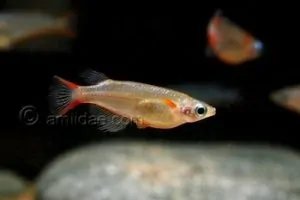Syncrossus beauforti – Chameleon Loach
The Chameleon Botia is often confused with Syncrossus bermorei, but can be distinguished from it by the presence of -smaller- dark spots over the body and head. It is a large fish that can grow to about 22 centimetres in length. Like all other Botia, it is a long slender fish with barbels. With these barbs, this fish searches for food in the bottom. The gender difference is difficult to see. The female is said to be slightly fuller than the male. As the Syncrossus beauforti ages, it loses some of its youthful fresh colours.
Syncrossus beauforti is found in Myanmar and Thailand. This species was previously classified in the Botia family, a no longer valid synonym is Botia beauforti.
Character
This Loach must be kept in a large tank of at least one and a half meters. Make sure that the tankmates are not too small, because this fish is very intolerant of other fish. It is quite aggressive towards other species. However, this Loach can be kept together with conspecifics. As long as there are enough hiding places, this will be fine. Keep in mind that you form a school of at least 5 specimens but preferably more. In this way, any aggression is distributed over the group and a natural hierarchy is created.
You can provide shelters using half coconuts, stones or, for example, driftwood. This fish is actually always active at night and will therefore hide during the day between the plants and in the hiding places.
Biotope
Typically, Syncrossus beauforti is found in clear, fast-flowing water over rocky substrate. They mainly occur in the smaller to medium-sized tributary rivers in the Mekong, Chao Phraya and Meklong basin.
In the wild, they dig burrows in the sand or under a rock. During the rainy season, they sometimes migrate to the flooded forest areas. As soon as the water starts to recede, they return to the rivers.
Diet
In the wild, this species feeds on molluscs and invertebrates. Syncrossus beauforti is quite a picky eater in the aquarium. It will usually accept large live food, but frozen food can also be accepted. They also feed on young fish.
The Aquarium
Because this fish likes to hide during the day, it is necessary that sufficient hiding places are available. This can be done by means of the above means, but a lot of planting also helps. Make sure that these plants are well established because this Loach likes to dig into the soil in search of food. Because the Chameleon Botia likes to go through the bottom with its barbels, a sandy bottom is required. When you use a gravel bottom, these threads quickly damage, which causes nuisance for the fish.
Syncrossus beauforti also likes some current in the tank. Aerating the water well and keeping it clean is very important. They are not resistant to high nitrate values. The lighting is preferably dimmed during the day. This can be done, among other things, by means of floating plants.
Because Syncrossus beauforti grows fairly large, up to about 30 centimetres, they also need a fairly large aquarium. Think of a minimum length of about 1 meter 50 for young animals and perhaps even longer as they get bigger.
Breeding
Captive breeding in the aquarium has so far not been successful.
Authors
P. de Pijper
J. de Lange
Copyright images
Nonn Panitvong – Siamensis.org
Michael Lo – JungleMikey











Reviews
There are no reviews yet.